Do you look for an easy-to-grow plant for your garden that needs less hassle to grow? Then you should think about growing ground cherries in your garden. Ground Cherrie is also known as strawberry tomato, husk tomato. The best part is it’s not only easy to grow but also very delicious. And, for that reason, today we are going to talk about how to grow ground cherries.
Though the name is ground cherries but actually it’s not a cherrie . Let us explain why. Ground cherry, scientifically known as physalis peruviana, is not an actual fruit or cherry. It is more related to nightshade plants such as tomatillos. In Latin America it is mostly known as the cape gooseberry. Ground cherries got this name because the cherries fall on the ground as they ripen. The taste of ground cherries is more like a combination of strawberry, pineapple with a slight hint of vanilla.
How to Grow and Plant Ground Cherries
How To Plant Ground Cherries: Step by Step
If you are going to plant ground cherries from seeds, start growing them indoors. And in that case, plant the seeds indoors at least six to eight weeks before the first frost.
Here is what you will need to collect the seeds: few ground cherries,knife,a small bowl, water, Strainer, paper towels. To help you understand the planting process better, here is a step by step guideline on how to grow ground cherries.
Step 1: Cut the Cherrie into Two Pieces
First, take few cherries and cut them into halves with a knife.
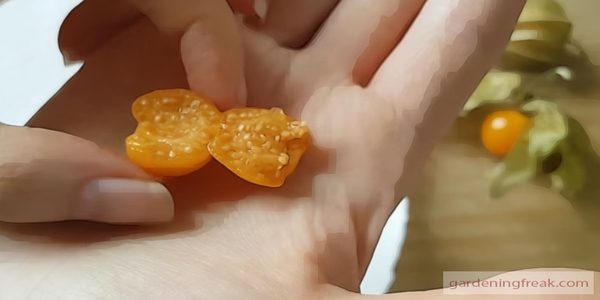
Step 2: Collect the Seed Inside a Water Bowl
And then, squeeze out the pulps and seeds into a bowl. Pour some water into the bowl and stir the pulps so that the seeds will get separated.
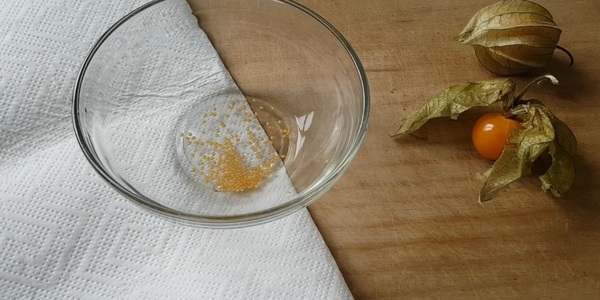
Step 3: Dry the Seed on a Paper Towel
You can use a thin fabric to strain or use a mesh strainer to pour out the water. Once the water is drained properly or strained, lay the seeds on a paper towel to dry.

Step 4: Prepare the Container/Pot and Plant the Seeds
After the seeds are well dried, it is time to plant them in a pot. The potting soil should be loose, well-fertilized, and well-drained. And, the planting pot also needs to have a sound water drainage system.
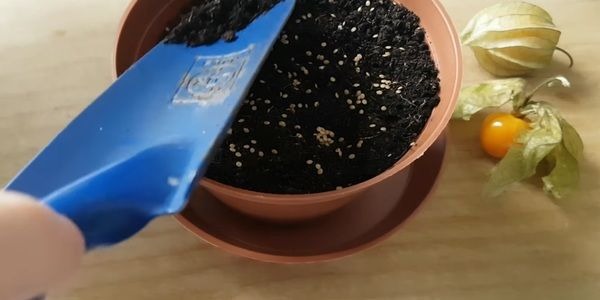
Fill the pot with soil and put the seeds on them. You do not need to follow any instructions to plant seeds in the pot. You need to cover them up with a thin layer of soil after the seeds are planted.
Step 5: Water and Sunlight
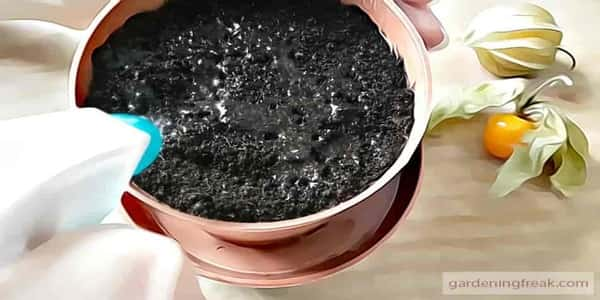
Ground cherry plants grow fast and healthy if the soil is moist. Water them once every two days, more or less. But, make sure the water does not overflow the pot. It should be enough to keep the soil moisture.The best thing to do is to use a sprinkler or spray can to water the plant. In this way, the soil covering the seeds will not wash away.
The indoor seeds do not require direct sunlight. Even though it is a sun-loving plant, exposing the young seedling to the heat can damage them. But if you are going to keep the planted seeds outdoor, cover them up with a plastic lid and keep them in the shade.
Step 6: Germination
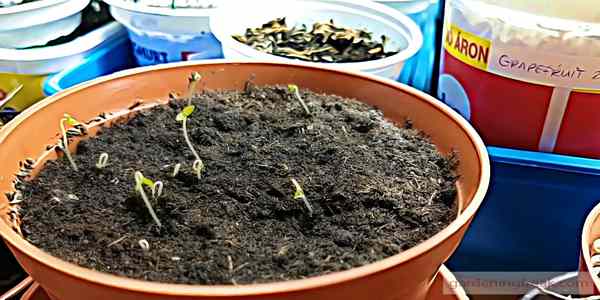
Did you notice that we instructed you to cut up a few ground cherries to gather seeds? It’s because not all the seeds that you plant will germinate.
Few days after planting the seeds, the seeds will begin to germinate, and the ground cherry seedlings will start to grow. You can place the pot near your window so that they can get light and warmth.
Step 7: Transplant and Grow
Six to eight weeks after the last frost date, the seedlings will be ready for transplantation. But, do not terminate them before they harden off properly.The distance between the plants should be at least two feet. And while planting, keep 2-3 sets of the leaf set above the soil and 3-4 inches of the plant in the ground.
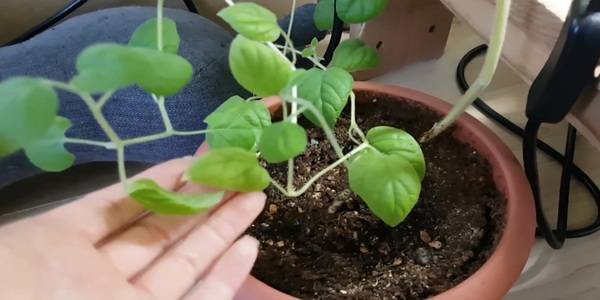
Ground cherry plants sprawl as they grow. Use a tomato cage around them after transplanting. It will prevent the sprawling and help the cherries grow upright.Water the plants immediately after you plant seedlings. Though ground cherries usually do not get pest attacks, it is better to check on them from time to time. Watering them regularly can keep them from suffering mites, flea beetles, or leaf beetles.
How To Harvest Ground Cherries
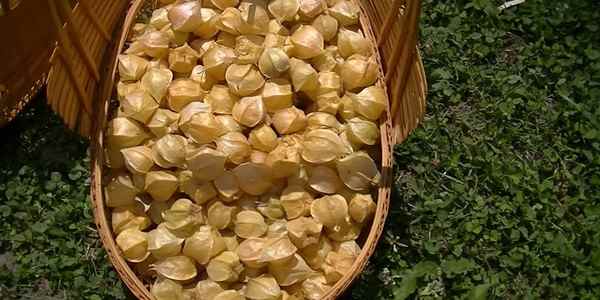
Ground cherries grow inside the plant flowers. The flower is bell-shaped and turns from green to yellow as the fruit grows inside it.Ground cherry plants grow slowly. It takes around 70-75 days for ground cherry fruit to grow and ripe fully.How would you know if the ground cherries are ready to be harvested? Well, that’s the easiest part of growing them. Ground cherry is husked fruit, and the husks turn papery and yellow as the fruits ripe.And, when it’s time to harvest, the ripe fruits fall on the ground on their own. Keep an eye under the sprawl to look for the fallen fruits and pick them up.
How To Save Ground Cherry Seeds
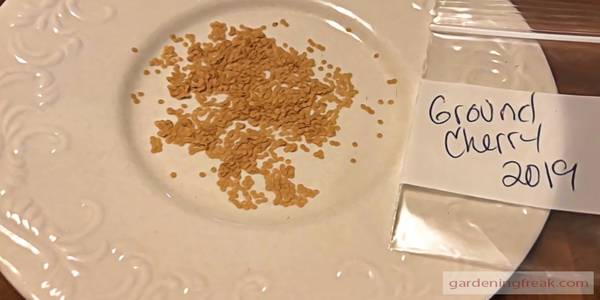
Sometimes it is good to save the seeds to pass them on to others. Besides, to grow ground cherries in the future, you would need the seeds.Saving ground cherry seeds is pretty much the same process of collecting seeds, as mentioned around the beginning. But we are informing you of another easier process to try.
Separate the Seeds From the Fruits:
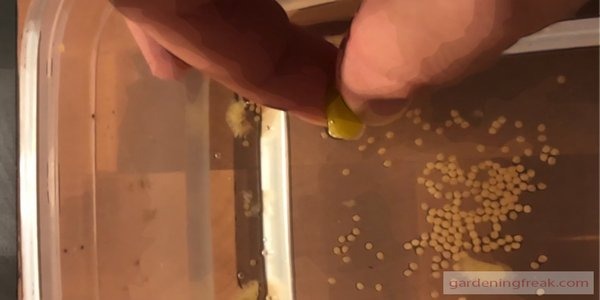
First, take a few ripe ground cherries and cut them in half. You will notice that each cherry contains lots of seeds. However, not all of these seeds will be useful.Then, take a container or bowl and pour some water in it. Take each half of the cherries and squeeze them in the bowl of water. Make sure all the seeds come out of skin and pulp. Stir the squeezed cherries in the water and let the seeds settle in the bottom of the bowl. And then, pour out some of the water so that the cherries’ unnecessary parts will be gone.
Identify the Good and Bad Seed:
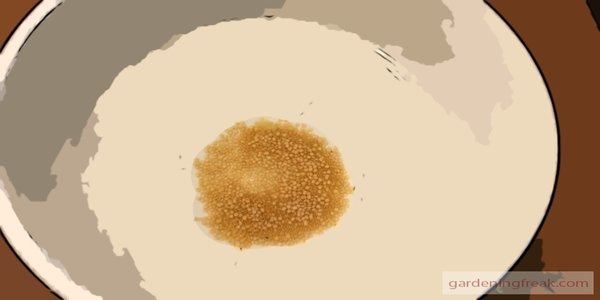
Again, pour some clean water and repeat the process until only the seeds remain. You might notice some seeds floating on the water. Pour them out as well because only the good seeds will sink, and the bad ones float.Pour the remaining seeds on a dish or paper towel and let the water soak. It is better to leave the seeds to dry for the next few days. And, ofnce they are properly dried, they will be ready to be stored or planted.
How To Store Ground Cherries
Depending on how long you want to store, the process of storing ground cherries can be different. If you plan to store the ground cherry for a short time, keep the husked fruits in the dark, cool, dry place. In this way, you can store them for as long as three months.
On the other hand, you can store or preserve the ground cherries for a longer time in the following ways:
Freezing
First of all, remove the husks. Then, lay the cherries on a baking sheet or tray and keep them in the freezer for a few hours. Once the cherries are frozen, pack them in a plastic bag or keep them in a glass jar.
Making Jam
The process of making ground cherry jam is the same as any other jam recipe. The jam can be an addition to the delicious desert during meals.
Dehydrating
Dehydrating is the same as dehydrating grapes for making raisins. Dehydrated ground berries can bring a tart flavor if you use them on cookies, muffins, or cupcakes.
These processes will allow the cherries to be stored for at least four years.
Ground Cherry Varieties
Here are some of the most commonly known and planted varieties:
Aunt Molly’s
This is the commonly available ground cherry. It is also known as cape gooseberry. It takes 70-75 days for Aunt Molly ground cherries to mature.
Chinese Lantern
These are known as Chinese lantern ground cherry because of their vibrant red-orange papery husk.
Goldie
This is one of the most productive ground cherries with a bright orange color. The difference between Goldie and Aunt Molly’s is the size of the spreading.
Mary’s Niagara
If you need ground cherries for a short growing season with fast-growing conditions, this variety is suitable. Mary’s Niagara ground berries grow and ripe faster and spread only three to four feet.
Cossack Pineapple
Just as the name suggests, with their husk, these cherry fruits look like a pineapple. Thus, it got its name.
Cossack pineapple
This Ground cherry plants grow only 12 to 18 inches and take 60 days to mature. But the wide-spreading and sweet flavor make up for it.
Ground Cherry Nutrition and Benefits
Maybe ground cherries are bite-size fruits. But, they are full of nutrition and benefits.
They are:
Low in Calories
Ground cherries are the most suitable thing to eat if you want to lose weight. Each 100g ground cherries contain only 53 calories and only 1gram of fat.
As it contains a large amount of fiber, it fills your stomach fast and stops you from overeating.
Source of Vitamins
The amount of various types of vitamins it contains is jaw-dropping. Ground cherries are full of Vitamin A, B-1, B-2, B-3, C, along with phosphorus, calcium, and iron.
Other Benefits
It is said that ground cherries are very effective in protecting you from reproductive organ cancer. They are being used to treat malaria, asthma, hepatitis, etc. They are also beneficial to help you improve your sleeping regulation.
Ground Cherry Companion Plants
When you grow ground cherries, some plants do and don’t grow well with ground cherry plants. These are called companion plants.Growing companion plants has different benefits. They help you use the left out space. And, planting crops like onions help you minimize pest attacks on your plants.Besides these, companion plants improve the flavor or neighbor plants, attract beneficial insects like lady bug, and help each other grow by providing nutrition and shade. Besides, Here are some of the good and bad companion plants to grow with ground cherries:
Good Companion for Ground Cherry
- Parsley
- Aster
- Basil
- Marigold
- Hot Pepper
- Onion
- Carrot
Bad Companions for Ground Cherry
- Potatoes
- Dill
- Corn
- Fennel
- Eggplant
Frequently Asked Questions About How To Grow Ground Cherries
Where to grow ground cherries?
Areas with a long growing season are more suitable to grow ground cherries as they need sunlight, warmth, and well-drained soil.You can grow the seeds first in indoor pots when they are young and wait for the seedlings to harden. Later, plant them on the ground. Raised beds are the best choice to grow ground cherries as they provide well soil drainage.
How to use ground cherries?
There are many ways to use ground cherries. Besides eating raw, these savory fruits are useful to make flavorful meals. Ground cherry is also known as cherry tomato and can be a great alternative to tomato in a salad.
Where to find ground cherries?
Even though it is believed that ground cherries originated in Brazil, it is found a great deal in the USA. It is available in North America, South America and Peru.
Through saving and preservation, the plants later spread in many parts of the world. You may find it in farming stores or buy online.
How do you eat ground cherries?
There is no particular way to eat ground cherries. It is too tempting not to pop one or two cherries in your mouth as soon as you notice the ripe fruit under the husk or on the ground.
However, you can eat ground cherries in dessert or use them in refreshing drinks. The whole ground cherry is edible, apart from the papery husk. So, take it off the cherry before eating.
Conclusion
If you already go through the entire article then we believe you already gain enough knowledge about how to grow ground cherries. So you are prepaid enough to ground this cherries.All you need to do is execute every task that you learn from here on your garden. Though many people still are not familiar with these sweet, wonderful plants, it is slowly spreading worldwide. It is so delicious that people also like to enjoy it while harvest it before making it to the kitchen. But be careful with the unripe cherries or the husks. They can mess up with your health as they are not for eating. But, the ripe ones can give you a sweet tooth.















